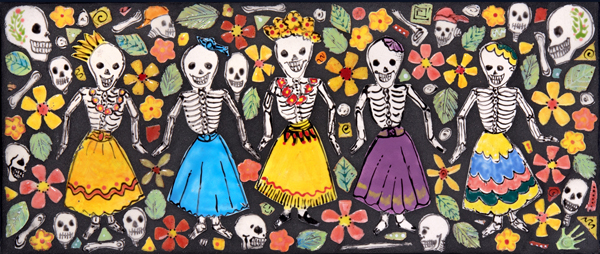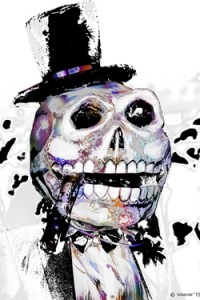Artistic Commemorations for the Dearly Departed

“Party Girls Forever” by Carol Hegedus.
On exhibit at Tohono Chul Park.
Día de los Muertos, the Mexican holiday that honors the deceased, has inspired some very lively artworks currently on display through Nov. 10 at Tohono Chul’s Main Gallery, 7366 N. Paseo del Norte. During the Sept. 13 opening, art lovers had the very pleasurable experience of following Tohono Chul Park’s curving walkway through native desert flora to arrive at the art gallery just as the sun disappeared below the Tucson Mountains.
Día de los Muertos (Day of the Dead) is a widely-observed holiday in Mexico that takes place annually on Nov. 1 and 2. Its origins are rooted in Aztec culture, and the observance has become an important part of Tucson’s culture.
Ben Johnson, Tohono Chul’s Curator of Exhibitions, explains the unique nature of the holiday and its art, saying, “I find that when we speak about death, we are actually speaking about life. In the ache of remembering departed friends and family, we are really feeling the beauty of their lives resonating in us deeply. I see this dichotomy in so many of the works in this exhibit. The poignancy and sweetness of life held together at once.”
This year’s exhibit, now in its tenth year, is noteworthy for its diverse range of mediums and interpretations of the holiday. Art includes paintings, prints, paper cuttings, sculptures of paper mâché and of recycled materials, ceramics, mosaics, artist’s books, beaded appliqués and quilts, window art and interactive shrines.
“I feel that the voices of these varied mediums and styles speak to the interesting space that exists between the individual and the larger human bond,” Johnson adds.
The iconic image from any Día de los Muertos celebration is the calavera or skull. Calaveras are in no short supply in the artwork, and despite their ubiquitous appearance, these skulls are as diverse and as engaging as the artwork itself.
The exhibit’s standouts are celebratory works such as the life-size paper mâché sculpture Catrina by Quetzally Hernandez Coronado, and Mel Dominguez’s piece Las Gitanas, a colorful and symbolic rendition of a Day of the Dead celebration in Tucson’s own Barrio Viejo. Carol Hegedus, in her tile mosaic Party Girls Forever, tells us of departed friends, “What normally stays with me is the memory of fun and play and the good times together.”
Beautiful pieces in the exhibit, among them Robyn Duenow’s finely wrought Momento and William Wiggins III’s Afterlife Paradise, offer a more serene view of what awaits us. Janet Windsor’s quilt, My Idea of Heaven, presents a personal view. “I cannot imagine a happier place to end up than at my sewing machine.”
Humor abounds in some pieces; among them Royce Davenport’s Crossing the Line (Meeting the Afterlife Head On). Recycled and discarded materials transform into a cocky motorist behind the wheel of his “ride” ready for a trip to the afterlife.
Life returning after death is seen in Jennie Norris’s painting The Offering. Sunflowers are in full bloom, and yet the calaveras are already present in the roots and creeping up stems. A small bird holding a seed waits patiently to offer another chance at life. Joan Binder’s large scale Community Ofrenda is invites visitors to write the names of dearly departed on cards and add them to the ofrenda (offering).
Two more serious works addressing cross-border migration include Alvaro Enciso’s Those Who Walked North #3 and Barbara Brandel’s collage painting, Small Paper Shrine that she created “in remembrance of the devastatingly dangerous and sad situation that is faced by border crossers and their families.”

“Untitled” by David Weaver
One especially compelling work is Untitled by David Weaver, created as a “layers and separations photographic process.” It depicts a top-hatted robber baron calavera with a cigar in his mouth. One wonders: Is that the American middle-class disappearing between those corporate teeth?
Johnson expounds on his view of the art: “The traditions inherent to Día de los Muertos are so rich and vivid, and the celebratory light that these observances shed on life and death are an inspiring force that I feel emanating from each of these works.”
On the actual day of the dead, Nov. 1, Tohono Chul Park hosts a Park After Dark event, 5 p.m.-8 p.m., which will include music by Rafael Moreno and Descarga, calavera face painting, Mexican food and drink, in addition to the artwork showing in Tohono Chul’s Main Gallery. Admission to the event is $10 for the general public, $5 for members and free for children under 13-years-old.
Tohono Chul is located at 7366 N. Paseo del Norte and its galleries are open daily from 9 a.m.-5 p.m. Admission is $10, adults; $5, students with ID & active military; $8, seniors (62+); $3 children 5-12. For further details, visit TohonoChulPark.org or call (520) 742-6455.




